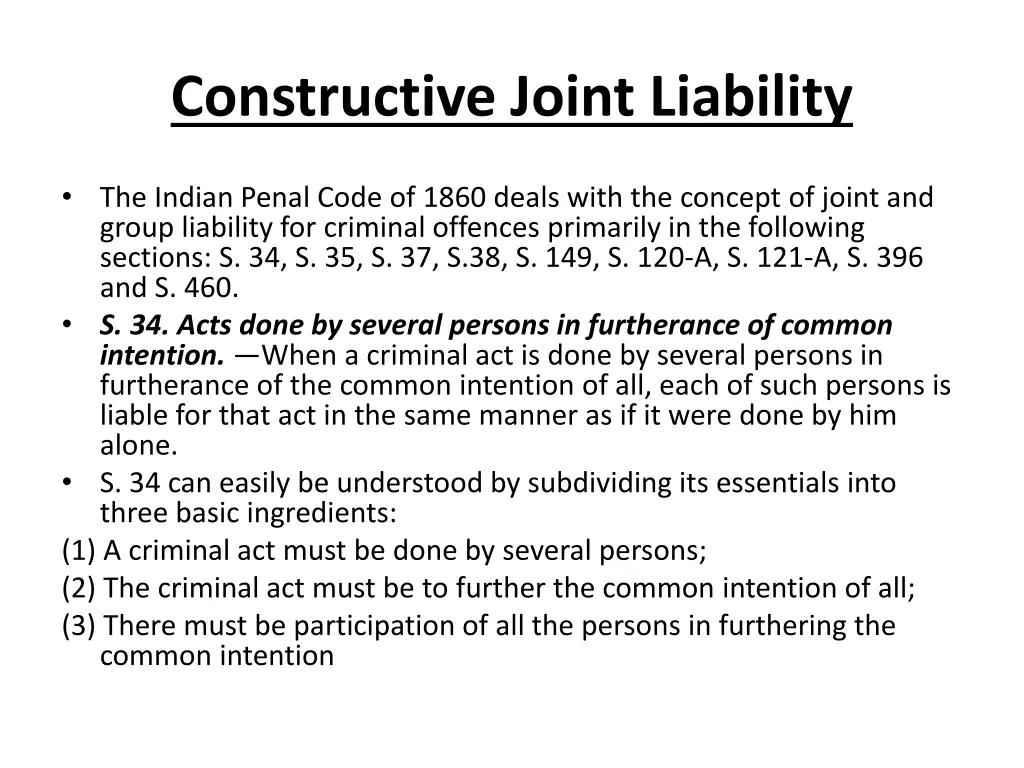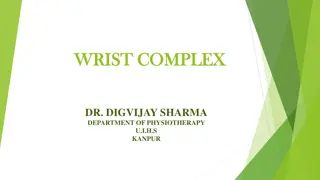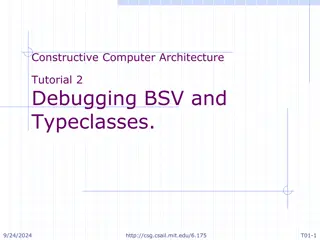
Constructive Joint Liability in Indian Penal Code of 1860
The Indian Penal Code of 1860 covers joint and group liability for criminal offenses through sections such as S.34, S.35, S.37, S.38, S.149, S.120-A, S.121-A, S.396, and S.460. Understanding the concept, distinctions between common intention and similar intention, and the principles of joint criminal liability are essential for legal proceedings related to joint liability. Common intention, premeditation, and evidentiary considerations play crucial roles in determining liability under S.34 and S.35.
Download Presentation

Please find below an Image/Link to download the presentation.
The content on the website is provided AS IS for your information and personal use only. It may not be sold, licensed, or shared on other websites without obtaining consent from the author. If you encounter any issues during the download, it is possible that the publisher has removed the file from their server.
You are allowed to download the files provided on this website for personal or commercial use, subject to the condition that they are used lawfully. All files are the property of their respective owners.
The content on the website is provided AS IS for your information and personal use only. It may not be sold, licensed, or shared on other websites without obtaining consent from the author.
E N D
Presentation Transcript
Constructive Joint Liability The Indian Penal Code of 1860 deals with the concept of joint and group liability for criminal offences primarily in the following sections: S. 34, S. 35, S. 37, S.38, S. 149, S. 120-A, S. 121-A, S. 396 and S. 460. S. 34. Acts done by several persons in furtherance of common intention. When a criminal act is done by several persons in furtherance of the common intention of all, each of such persons is liable for that act in the same manner as if it were done by him alone. S. 34 can easily be understood by subdividing its essentials into three basic ingredients: (1) A criminal act must be done by several persons; (2) The criminal act must be to further the common intention of all; (3) There must be participation of all the persons in furthering the common intention
Constructive Joint Liability Common intention here must be shown to be premeditated. However, it is possible that there may be incidents in which common intention may develop on the spot, after the offenders have gathered. Proof of such common intention must needs be gleaned from the facts and circumstances of the individual case. Common intention differs from same or similar intention. S. 34 can only be invoked in cases of common intention. To constitute common intention it is necessary that the intention of each person be known to all the others and be shared by them, whereas this is not the case in same or similar intention. Furthermore, in the absence of conclusive proof of common intention, individual offenders will be liable only for individual acts. The benefit of the doubt is always on the side of the accused. It is imperative to note here that S. 34 is only a rule of evidence and does not create a substantive criminal offence.
Constructive Joint Liability All those charged with the criminal offence must have necessarily participated in it if the principle of joint criminal liability is to be brought into operation. Common intention can also be proved via circumstantial evidence i.e. no direct evidence is required to prove it the conduct of the parties involved and the attendant circumstances, if when analyzed provide sufficient reason to infer common intention, are enough to attract the doctrine of joint liability.
Constructive Joint Liability S. 35: When such an act is criminal by reason of its being done with a criminal knowledge or intention. Whenever an act, which is criminal only by reason of its being done with a criminal knowledge or intention, is done by several persons, each of such persons who joins in the act with such knowledge or intention is liable for the act in the same manner as if the act were done by him alone with that knowledge or intention. S. 34 deals with an act pursuant to the formation of a common intention. S. 35 creates what is known as like intention.
Constructive Joint Liability Sec 36- Effect caused partly by the act and partly by omission. This Section follows as a corollary from S. 32. The legal consequences of an act and of an omission being the same, if an offence is committed partly by an act and partly by omission.
Constructive Joint Liability S. 37: Cooperation by doing one of several acts constituting an offence. When an offence is committed by means of several acts, whoever intentionally cooperates in the commission of that offence by doing any one of those acts, either singly or jointly with any other person, commits that offence. The difference between S. 34 and S. 37 is that S. 34 calls for common intention and a unity of criminal behaviour arising thence which causes the criminal act to be committed and then punishes each participant as though the act were done by him alone. S. 37, however, is based on intentional cooperation in an offence committed by means of several acts, and then goes on to punish such cooperation in any of the acts (committed singly or jointly) as if it constituted the offence itself. Importantly, intentional cooperation could clearly differ from common intention.
Constructive Joint Liability S. 38: Persons concerned in a criminal act may be guilty of different offences. Where several persons are engaged or concerned in the commission of a criminal act, they may be guilty of different offences by means of that act. S. 38 has to do with acts that could involve differing intentions. It provides for different punishments for different offences and thus makes space for the possibility that the same criminal act could be done jointly but by people who have different intentions thereto, and hence must be held liable for different offences.






















